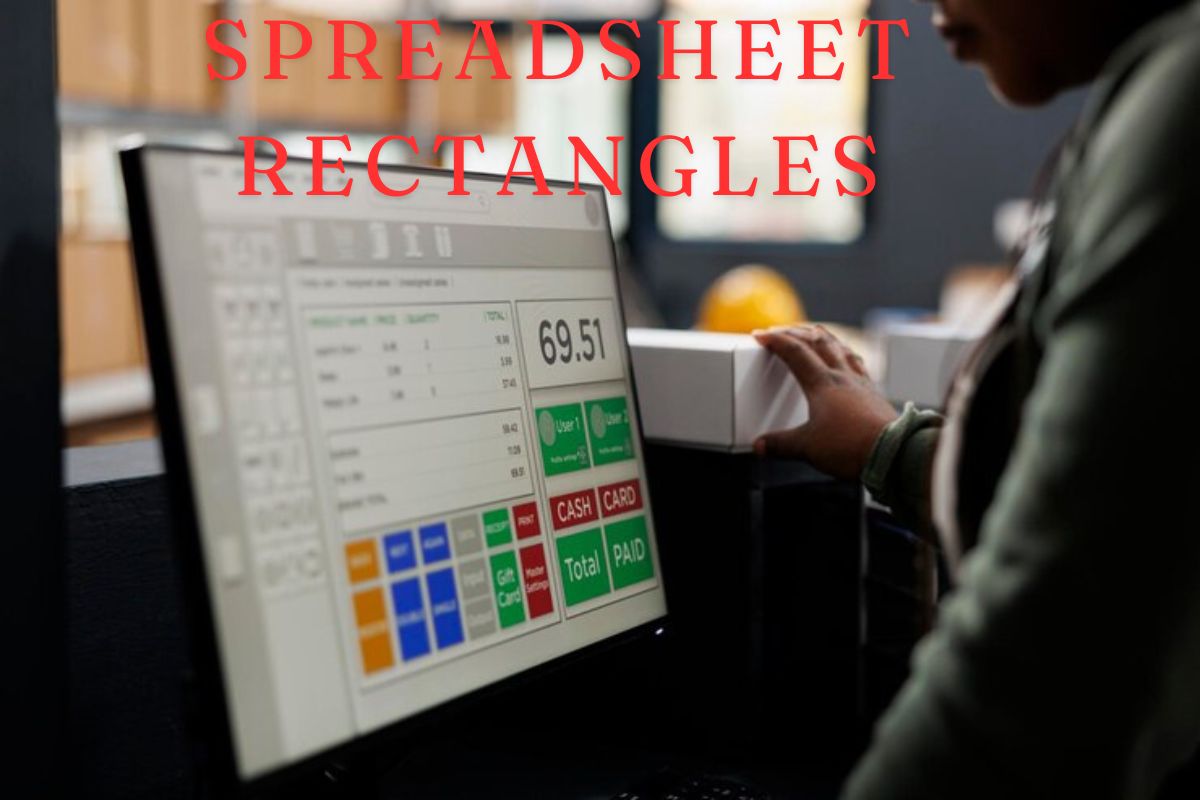Technology
Spreadsheet Rectangles: Unlocking Efficient Data Organization

In the world of spreadsheets, effective data management is paramount for maximizing productivity. One of the most powerful concepts that underpins this efficiency is the use of spreadsheet rectangles. These rectangles represent the blocks of cells formed by intersecting rows and columns. Understanding how to define, manipulate, and optimize these blocks is crucial for organizing, analyzing, and visualizing data effectively.
What Are Spreadsheet Rectangles?
At their core, spreadsheet rectangles are contiguous groups of cells in a spreadsheet that stretch across multiple rows and columns. They are defined by a top-left cell and a bottom-right cell, forming a rectangular range. For instance, if you define the range A1
in a spreadsheet, this rectangle will include every cell from A1 through C5. Whether working with one or multiple cells, rectangles are fundamental tools for structuring data logically and efficiently.
These rectangles can vary in size and purpose, encompassing everything from a single cell to larger groups of cells that represent detailed data sets. Identifying and utilizing rectangles within your spreadsheet forms the backbone of advanced data operations like sorting, calculating, or visualizing information.
Importance of Spreadsheet Rectangles in Data Management
The use of spreadsheet rectangles extends beyond simple cell selection. They provide a structured way to handle large datasets, making it easier to organize, analyze, and visualize information.
- Data Organization: By grouping related data in rectangular blocks, users can easily manage sales figures, inventories, or financial reports. The logical placement of these groups simplifies navigation and retrieval of information.
- Efficient Data Analysis: Functions such as SUM, AVERAGE, and COUNT can be applied directly to rectangles, speeding up the analysis of large datasets. This structured format allows for quick insights, especially when dealing with complex spreadsheets.
- Visual Representation: Rectangles are also key in generating charts, graphs, or dashboards, ensuring that your visual representations accurately reflect the data behind them. This is especially helpful when presenting trends or patterns in business reports.
Selecting and Manipulating Spreadsheet Rectangles
Selecting a rectangle is the first step in working with any group of cells. Here’s how you can do it:
- Click and Drag: The simplest method involves clicking on a cell, holding the mouse button, and dragging it to cover the desired range. This is ideal for selecting adjacent cells quickly.
- Keyboard Shortcuts: For users preferring the keyboard, holding down the
Shiftkey and using the arrow keys allows you to expand your selection across multiple rows or columns without touching the mouse. - Direct Input: In applications like Excel, you can also type the cell range (e.g., A1) directly into the name box to select a rectangle. This method is precise and useful when dealing with large spreadsheets.
Once selected, spreadsheet rectangles offer endless possibilities for manipulation, such as copying, pasting, or formatting. For instance, copying data from one rectangle and pasting it into another retains the structure, ensuring no information is lost.
Optimizing Data with Spreadsheet Rectangles
To optimize your use of rectangles, here are a few best practices that can elevate your workflow:
- Conditional Formatting: Use conditional formatting within rectangles to highlight specific data points, such as outliers or trends. This visual aid simplifies data interpretation, enabling quicker decision-making.
- Data Validation: By setting up data validation rules, you can ensure that only specific types of data are entered within a rectangle. This helps in maintaining accuracy across the spreadsheet, especially when working in collaborative environments.
- Named Ranges: Assigning names to rectangles can streamline formula creation and improve readability. For instance, naming a range “SalesData” instead of referencing individual cells like B2enhances clarity and reduces errors.
- Dynamic Ranges: When working with constantly evolving datasets, dynamic ranges ensure that formulas and charts update automatically as data is added or removed. This feature is particularly useful when dealing with regular updates in reports.
Common Mistakes to Avoid with Spreadsheet Rectangles
While mastering rectangles can greatly improve your spreadsheet efficiency, it’s also important to avoid these common mistakes:
- Overcomplicating Layouts: Simplicity is key. Too much formatting or excessive categorization can clutter your spreadsheet, making it harder to read. Stick to essential information and logical groupings.
- Inconsistent Formatting: Consistency is crucial for clarity. Ensure that your rectangles have uniform formatting and data entry standards to prevent confusion and errors in your spreadsheet.
- Neglecting Data Backup: Always back up your spreadsheets, especially when working with large datasets. Losing your carefully organized rectangles can set you back significantly.
Conclusion: Mastering Spreadsheet Rectangles for Success
Understanding and utilizing spreadsheet rectangles is fundamental to improving the efficiency of your data management and analysis. Whether you’re a novice or an experienced spreadsheet user, mastering these rectangular structures will elevate your spreadsheet skills, allowing you to manage information more efficiently and make informed decisions faster. By organizing data into well-defined rectangles, utilizing advanced functions, and avoiding common mistakes, you can transform your spreadsheets into powerful tools that simplify even the most complex datasets.
Also Read: MobileHomeExteriors.com: Elevating Your Mobile Home’s Curb Appeal
FAQs
What are spreadsheet rectangles?
Spreadsheet rectangles refer to the blocks of cells formed by intersecting rows and columns, which are used to organize, input, and analyze data.
How can spreadsheet rectangles improve data management?
They help in organizing related data in one area, simplify analysis with functions like SUM or AVERAGE, and enhance the presentation of data through charts and graphs.
Can I use conditional formatting in spreadsheet rectangles?
Yes, you can apply conditional formatting to highlight important data within a rectangle, such as using color scales to show trends.
What are dynamic ranges in spreadsheets?
Dynamic ranges automatically adjust as data is added or removed, ensuring that your formulas and charts stay up to date with the latest data.
Why is data validation important in rectangles?
Data validation ensures that only specific types of data are entered into a rectangle, helping to maintain accuracy and consistency across the spreadsheet.
How do named ranges help with spreadsheet rectangles?
Named ranges make it easier to reference specific rectangles in formulas, enhancing clarity and reducing the chance of errors.
Technology
Latest FeedBuzzard.com | Stay Ahead with Fresh Insights

Keeping pace with the rapidly evolving digital world is no easy task. For professionals and enthusiasts looking to stay informed, FeedBuzzard.com has become the go-to hub for insights, trends, and predictions across a spectrum of industries. From cutting-edge technologies to impactful general news, FeedBuzzard is designed to help you soar above the competition with clarity and purpose.
Why FeedBuzzard.com is the Ultimate Destination for Insights
FeedBuzzard.com sets itself apart by providing value-driven contentcarefully curated to empower decision-makers.
- Expertly Curated Content
Articles on FeedBuzzard are crafted and selected by seasoned professionals with a deep understanding of various industries. Whether you’re looking for market insights, tech breakthroughs, or impactful best practices, you can trust FeedBuzzard to deliver high-quality, relevant content.
- Wide Range of Topics
FeedBuzzard covers everything from the latest in wearable tech to global tech market trends. Each category represents an opportunity to stay informed, including new advancements in biotechnology, gaming strategies, marketing mistakes to avoid, and more.
- Actionable Insights
Insights on FeedBuzzard are not just informative—they’re actionable. The articles are structured not only to educate but also to inspire immediate next steps, whether it’s implementing a cutting-edge tech solution or refining your digital marketing campaign for better ROI.
Explore Key Content Categories on FeedBuzzard
Technology and Computing
From how AI and robotics are reshaping industries to the future of private cloud solutions, the tech section dives deep into the advancements transforming our world.
General News
FeedBuzzard ensures you’re never out of touch with trending global news that matters. Discover valuable insights into regulatory changes, socio-political impacts on markets, and industry-shaping narratives.
Latest Trends Across Industries
Stay ahead of the curve with FeedBuzzard’s coverage of the most impactful trends across industries. Whether it’s the rise of bioinformatics in healthcare or the role of branding technology in modern business, these articles keep you informed of innovations that are shaping the future.
Marketing and Engagement
Master the art of connecting with your audience. FeedBuzzard offers articles aimed at refining strategies for affiliate marketing, content curation, and digital engagement, ensuring that your voice stands out across the increasingly competitive digital landscape.
Gaming and Wearable Tech
Dive into the world of gaming strategies or understand how wearable technology is elevating athletic performance. FeedBuzzard explores these niche categories with rich detail and practical insights.
How FeedBuzzard Delivers Value
1. Timely Updates
FeedBuzzard provides real-time updates so readers never miss an important development in their preferred sectors.
2. Expert Predictions
Tap into foresight that’s powered by market research and expert opinions. FeedBuzzard equips leaders and enthusiasts with insights to make informed decisions.
3. Community Engagement
Join the conversation, leave comments, and engage with a vibrant readership of like-minded professionals and enthusiasts.
Don’t Just Follow Trends, Stay Ahead of Them
The content on FeedBuzzard is designed not just to inform but to empower. Bookmark the platform for regular doses of groundbreaking information and actionable guidance.
Join the Buzz Today
Looking to future-proof your knowledge and skills? Explore the latest insights on FeedBuzzard.com today. Whether you’re a tech enthusiast or a marketing maven, there’s something valuable waiting for you!
Final Thoughts
FeedBuzzard is more than just a source for updates; it’s a tool for staying strategically ahead in a fast-evolving world. With expertly curated insights, interactive community features, and actionable guidance, FeedBuzzard equips you to thrive in your professional and personal ventures. Don’t settle for merely keeping up—choose FeedBuzzard and position yourself to lead the way. Stay informed, stay inspired, and stay ahead.
Conclusions
FeedBuzzard represents an indispensable resource for anyone striving to excel in a competitive and dynamically changing environment. By combining authoritative insights, a collaborative community, and practical tools, the platform empowers its audience to gain a strategic edge. It’s not just about consuming information—it’s about transforming knowledge into impactful action. Start leveraging the benefits of FeedBuzzard today and unlock your potential to not only adapt but to lead with confidence in an interconnected world. FeedBuzzard isn’t just a platform; it’s your partner in success.
FAQs
What is FeedBuzzard?
FeedBuzzard is a comprehensive platform designed to deliver curated insights, foster interactive community engagement, and provide actionable tools to help users excel in both their professional and personal lives. It is your go-to resource for staying ahead in a competitive, fast-paced world.
Who can benefit from FeedBuzzard?
Anyone looking to gain a strategic advantage in their field can benefit from FeedBuzzard. Whether you’re a professional, entrepreneur, student, or someone simply eager to remain informed and inspired, FeedBuzzard offers tools and insights tailored to your needs.
How does FeedBuzzard curate its content?
FeedBuzzard relies on expert curation, advanced algorithms, and industry-leading contributors to ensure that the information provided is both timely and authoritative.
Is FeedBuzzard a free platform?
FeedBuzzard offers flexible subscription plans, including both free and premium options. The free version provides access to essential features, while the premium plans unlock advanced tools, exclusive content, and enhanced community engagement.
How do I get started with FeedBuzzard?
Getting started is simple! Visit our website, create an account, and explore the various features available to you. Whether you’re browsing insights or connecting with the community, FeedBuzzard makes it easy to hit the ground running.
Can I connect with other users on FeedBuzzard?
Absolutely! FeedBuzzard’s interactive community features allow you to network with like-minded individuals, collaborate on ideas, and engage in meaningful discussions that enhance your growth and success.
What makes FeedBuzzard unique?
FeedBuzzard differentiates itself by combining authoritative content, a collaborative community, and practical tools—all in one user-friendly platform. It is not just about gaining knowledge; it’s about turning that knowledge into actionable strategies that drive results.
Technology
Success100x.com: Unlock the Key Success Factors

Success is a universal aspiration. Whether you’re chasing career milestones, financial freedom, or personal growth, the road to success is often paved with challenges and learning opportunities. That’s where Success100x.com comes in—a knowledge hub designed to help you uncover the critical factors that drive success across various domains, including career, personal development, and wealth creation.
You might wonder, what are the “key success factors,” and how can they transform your life or business? Thanks to expert insights and in-depth analyses provided by Success100x.com, we’ve broken down success into actionable steps. Keep reading to explore how mastering these elements can unlock your fullest potential.
What Are Success Factors?
At its core, a success factor is an attribute, mindset, or action that significantly contributes to achieving a desired outcome. For example, self-discipline and emotional intelligence are powerful success factors across personal, professional, and financial domains. Recognizing these factors and incorporating them into your life can provide clarity, purpose, and a competitive edge.
Success100x.com is dedicated to breaking each factor into actionable frameworks that simplify even the most complex success strategies.
Why Success Factors Matter
Understanding and adopting key success factors can change not only how you achieve your goals but also how efficiently you reach them. Businesses that lack focus on success factors often experience stagnation or struggle. On a personal level, misaligned efforts lead to frustration and unmet potential.
Here’s why success factors are game-changing:
- Clarity: Success factors help you identify what truly matters, so your every decision aligns with your ultimate goals.
- Actionable Insights: They eliminate guesswork, giving you a blueprint for action that’s rooted in strategy.
- Competitive Edge: Whether you’re running a business or growing personally, mastering these factors sets you apart.
- Sustainability: Success isn’t just about achievement—it’s about maintaining progress long-term.
The Pillars of Success100x.com
Success100x.com explores success factors across five key areas to provide an all-encompassing approach to unlocking your potential.
1. Career & Business Success
The modern workplace is brimming with opportunities, but navigating it requires the right tools and mindset. Success100x.com shares insights for building a successful career, from networking strategies to leadership tips. Business-oriented readers can learn how to create a sustainable competitive advantage, manage teams effectively, and dominate changing market dynamics.
Key takeaways for career and business success include:
- Prioritizing emotional intelligence (EI)—more valued than technical skills by 71% of employers today.
- Developing a mindset for adaptability to thrive in an evolving professional landscape.
- Harnessing self-awareness as a predictor of executive success.
Featured Reading: How to Be Successful in Business
2. Finance & Wealth Management
Financial freedom often feels elusive, but it’s achievable with the right habits and strategies. Success100x.com highlights the pivotal factors that differentiate the financially successful from those constantly chasing wealth. These include cultivating a long-term mindset, automating savings, and understanding investment risks.
Standout strategies include:
- Leveraging the 80/20 rule for smarter wealth accumulation.
- Adopting habits like tracking expenses and investing consistently.
- Building an intellectual framework for making decisions based on real value rather than emotional impulses.
3. Personal Development
Success begins with self–improvement. Success100x.com emphasizes that personal growth is foundational to achieving goals in any domain. From overcoming procrastination to improving productivity, the curated personal development advice inspires action.
Within this domain, readers explore:
- Strategies to break patterns of fear-based procrastination.
- Simple routines for habit stacking, creating compounding results over time.
- Building a growth mindset, essential for resilience and adaptability.
Featured Reading: Personal Development for Success
4. Mindset & Habits
Success100x.com dives deep into how to cultivate successful habits and reframe negative thinking patterns into productive ones. These lessons range from mindfulness practices to habit optimization.
Explore actionable advice, such as:
- Starting your day with intentional morning rituals to spark productivity.
- Understanding the science of habit loops to develop lasting behaviors.
- Practicing daily gratitude, which is closely tied to long-term happiness and motivation.
5. Navigating Success in an Uncertain Future
The future often brings challenges we couldn’t anticipate—new markets, disruptive technologies, and societal shifts. Success100x.com is packed with resources that help you future-proof your career, business, and finances.
Top-trending discussions focus on:
- The increasing importance of emotional intelligence over IQ by 2025.
- Learning how to master the fine balance of persistence and flexibility.
- Leveraging AI and automation to enhance productivity without becoming dependent on technology.
How to Apply these Success Factors Today
Success100x.com provides practical exercises, real-world examples, and community engagement tools that guide you every step of the way.
For starters:
- Identify your goals across career, finances, and personal growth.
- Choose one or two success factors to focus on for the next 30 days.
- Use the tools and resources on Success100x.com to measure progress and adjust tactics.
Remember, small, consistent actions compound over time.
Transform Your Potential with Success100x.com
Success isn’t magical—it’s methodical. Success100x.com bridges the gap between ambition and achievement, giving professionals, entrepreneurs, and dream-chasers the tools to thrive.
Are you ready to unlock the keys to your success? Start now by exploring Success100x.com and discover how big change often starts with a single step.
Final Thoughts
Success is a journey, not a destination, and every step you take matters. By leveraging the powerful tools and strategies available on Success100x.com, you’re choosing to invest in your growth and future. Remember, transformation comes through focused effort, perseverance, and the willingness to adapt along the way. Now is the time to take control of your potential—embrace the opportunity to create the life and career you’ve envisioned. Don’t wait for the perfect moment; start today. Success is within your reach.
Conclusions
Achieving success requires a clear vision, actionable strategies, and the determination to see them through. Success100x.com provides the resources and insights needed to help you take decisive steps toward your goals. Take that first step confidently, and watch as the doors to new opportunities and achievements begin to open. The future of your success begins with the choices you make today.
FAQs
1. What is Success100x.com and how can it help me?
Success100x.com is a platform designed to provide actionable strategies, expert resources, and valuable insights to help individuals achieve their goals.
2. Who can benefit from Success100x.com?
Anyone with a desire to grow, improve, and achieve can benefit from Success100x.com. It doesn’t matter if you are a working professional, entrepreneur, student, or someone looking to enhance your personal life—our tools and strategies are tailored to fit diverse backgrounds and ambitions.
3. Is Success100x.com suitable for beginners?
Absolutely! Whether you’re just starting your self-improvement journey or are experienced and looking for additional guidance, our resources are clear, actionable, and easy to adapt to your unique needs.
4. What kind of resources does Success100x.com offer?
We offer a variety of resources, including expert-led guides, motivational content, goal-setting strategies, and practical advice to inspire and support your progress. Each tool is designed to help you identify goals, create action plans, and maintain the determination required to achieve success.
5. How can I get started with Success100x.com?
Getting started is simple. Visit Success100x.com, explore the free content available, and sign up to access advanced tools and insights. Begin by defining your goals and leveraging our strategies to set yourself on the path to success today.
Technology
6462281081 | Expert Billing and Coding Services

Medical billing and coding form the backbone of any successful healthcare practice. These critical functions ensure that providers receive accurate and timely payment for the services they deliver. Yet, the complexities of navigating insurance claims, adhering to regulations, and keeping up with constantly changing codes have made billing a challenge for many in the healthcare industry.
This is where expert medical billing and coding services come in. Outsourcing to professionals in this field offers a precision-driven, streamlined approach that minimizes errors, reduces denials, and maximizes revenue for healthcare practices of all sizes.
If you’re a physician, clinic, or healthcare organization struggling with billing inefficiencies, the following guide will explain why investing in expert billing and coding services is not just an option, but a necessity.
The Challenges of Medical Billing and Coding
Medical billing and coding is a highly specialized process that involves converting healthcare services into universal alphanumeric codes. These codes are then used to create claims for submission to insurance companies, ensuring providers receive payment for their work. However, this process is fraught with challenges:
1. Constantly Changing Regulations
Healthcare regulations evolve rapidly, and billing codes are frequently updated. For example, the transition from ICD-9 to ICD-10 expanded the number of codes from 13,000 to more than 68,000. Keeping up with these changes is time-consuming and requires specialized knowledge.
2. High Error Rates
According to industry data, as many as 80% of medical bills contain errors. These mistakes can lead to claim rejections, delayed payments, or even financial losses. The most common errors include incorrect codes, patient information mismatches, and missed deadlines for claim submissions.
3. Administrative Burden
For physicians and clinic staff, balancing patient care with tedious administrative duties is an ongoing struggle. Inefficient billing systems can pull valuable resources away from patient care, leading to stress and burnout.
4. Rising Denial Rates
Claim denials are a persistent problem. Billing mistakes, lack of documentation, or missing authorizations can result in denied claims, leaving practices with unreimbursed services. Resolving these denials demands expertise and follow-up actions that often overwhelm in-house teams.
Why Outsourcing Billing and Coding Is the Smart Choice
To address these challenges, many healthcare practices are turning to expert medical billing and coding services. Here’s why this approach is so effective:
1. Expertise and Accuracy
Professional billing services employ certified coders who stay updated on the latest industry standards, including CPT, ICD-10, and HCPCS codes. Their in-depth knowledge ensures claims are submitted accurately, significantly reducing errors and improving reimbursement rates.
2. Enhanced Efficiency
Outsourcing billing and coding tasks streamlines workflows and eliminates inefficiencies. Practices no longer have to worry about juggling claim submissions, follow-ups, and compliance checks—specialized teams handle it all, freeing up time for patient care.
3. Cost Savings
Although outsourcing requires an upfront investment, it often proves more cost-effective in the long run. Practices save on overhead costs for hiring, training, and maintaining dedicated billing staff while avoiding revenue losses caused by errors or delays.
4. Faster Payments
Expert billing services are well-versed in creating clean claims and resolving rejected or denied claims promptly. This high level of efficiency leads to quicker payments, which keeps your revenue cycle consistent and dependable.
5. Compliance and Risk Management
Medical billing comes with stringent compliance requirements, from HIPAA protection to payer-specific billing rules. A reputable billing partner ensures that all procedures align with regulations, minimizing the risk of audits or penalties.
Key Features of Professional Billing and Coding Services
When you partner with an expert medical billing and coding service provider, you gain access to a suite of features designed to optimize your practice’s revenue cycle:
Advanced Technology
Professional billing companies leverage state-of-the-art software to automate processes, track claims, and predict trends. Their systems integrate with electronic health records (EHR) for seamless data transfer.
Comprehensive Claims Management
From initial claim submission to post-payment reconciliation, every step of the billing process is carefully managed. Dedicated teams follow up on denied or underpaid claims, ensuring no revenue is left on the table.
Detailed Reports and Transparency
Reputable services provide detailed reports on your revenue cycle performance. Metrics such as claim approval rates and days in accounts receivable give you full visibility into the financial health of your practice.
Customization for Specialties
Whether you’re a cardiologist, dermatologist, or mental health provider, expert billing services cater to the unique needs of your specialty. Their tailored approach ensures accurate coding and documentation specific to your field.
How Expert Billing Services Impact Your Revenue Cycle
Partnering with professionals in billing and coding can transform your revenue cycle management in the following ways:
- Reduce Days in Accounts Receivable (AR): Expert billers expedite the claims process, reducing delays in payments.
- Increase Revenue: By minimizing errors and reducing denials, your practice sees a steady increase in reimbursements.
- Improve Patient Satisfaction: With administrative burdens lifted off your team, more focus is placed on providing excellent patient care.
Who Can Benefit From Expert Billing and Coding Services?
These services benefit a wide range of healthcare providers, including:
- Physician Practices: Solo and group practices that need efficient billing solutions to manage growing patient volumes.
- Specialty Clinics: Providers in fields like cardiology, dermatology, and orthopedics require specialized coding expertise.
- Hospitals and Surgery Centers: Large organizations rely on expert billing to handle complex claims and ensure compliance.
- Therapists and Mental Health Professionals: Accurate billing for therapy sessions and mental health treatments is essential for steady cash flow.
Choosing the Right Billing Partner
Not all billing services are created equal. To find the right partner for your practice, consider these factors:
- Experience and Reputation: Look for a provider with a proven track record in medical billing across different specialties.
- Technology and Integration: Ensure they use modern software that integrates seamlessly with your practice management system.
- Transparent Pricing: Select a company that offers clear pricing models without hidden fees.
- Customer Support: A reliable partner is always there to address concerns and provide updates on your account’s performance.
Elevate Your Practice With Expert Billing Services
Medical billing and coding are too important to leave to chance. By outsourcing these complex tasks to seasoned professionals, you unlock the full potential of your revenue cycle while freeing up valuable time to focus on what matters most—your patients.
If you’re ready to improve your practice’s financial health and operational efficiency, consider partnering with experts in the field. It’s time to take the next step toward seamless revenue management.
Don’t just settle for average—choose exceptional. Contact us today to learn how our expert billing and coding services can transform your practice.
Final Thoughts
Efficient and accurate medical billing is the backbone of a thriving practice. Partnering with industry professionals ensures you not only maximize your revenue but also gain peace of mind knowing that your billing processes are handled with precision and care. By entrusting experts with these essential tasks, you can redirect your energy toward delivering exceptional patient care and growing your practice. The choice is clear—take control of your financial success and partner with those who prioritize your practice’s prosperity.
Conclusions
The success of any medical practice hinges on its ability to manage complex billing processes efficiently and effectively. By investing in professional billing and coding services, practices can unlock their full potential, ensuring steady revenue flow while reducing administrative burdens. This strategic approach not only enhances operational efficiency but also empowers healthcare providers to focus entirely on their core mission—offering exemplary patient care. It’s time to prioritize the financial health of your practice and choose a solution that drives lasting growth and peace of mind.
FAQs
1. Why should I outsource my medical billing and coding?
Outsourcing medical billing and coding helps reduce errors, ensures compliance with industry regulations, and speeds up reimbursement processes. This allows healthcare providers to focus on patient care without the stress of managing complex billing procedures.
2. How does outsourcing billing improve revenue flow?
Professional billing services are dedicated to accurate and timely claim submissions, minimizing denials and delays. This consistent approach ensures a steady revenue stream, improving the financial stability of your practice.
3. Will outsourcing compromise patient data security?
No, reputable billing services follow stringent data protection protocols to ensure compliance with HIPAA regulations and safeguard patient information. Always partner with a service provider that prioritizes security and confidentiality.
4. How do I know if my practice needs professional billing services?
If your practice is experiencing frequent claim denials, slow reimbursements, or excessive administrative workload, it might be time to consider professional billing services. It’s a strategic investment to streamline operations and improve profitability.
5. Can outsourcing billing reduce administrative costs?
Yes, outsourcing eliminates the need for in-house billing staff and related overhead costs. This reduction in administrative expenses allows practices to allocate more resources to patient-centered initiatives.
-

 Technology9 months ago
Technology9 months agoHonor Magic 5 Pro: A Comprehensive Review
-

 Blogs7 months ago
Blogs7 months agoпоррозаб: The Ultimate Guide to Origins, Uses, and Benefits
-

 Blogs9 months ago
Blogs9 months agoMobileHomeExteriors.com: Elevating Your Mobile Home’s Curb Appeal
-

 News9 months ago
News9 months agoShari Ann Chinnis: A Pillar of Leadership and Service in Indianapolis
-

 Entertainment9 months ago
Entertainment9 months agoFrench Stream.moe : Ultimate Guide to Watch Free Now
-

 Technology9 months ago
Technology9 months agoMaximizing Efficiency with Identifier b88221141 System
-

 Law9 months ago
Law9 months agoPaul Mackoul, MD: A Closer Look at the Recent Lawsuit and Its Implications
-

 Health9 months ago
Health9 months agoUnlocking the Secrets to Health and Wellness: Insights from The //Vital-Mag.net
